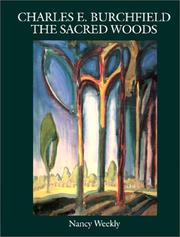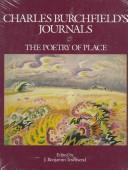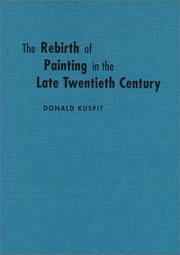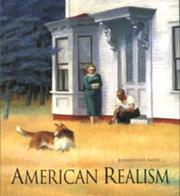| Listing 1 - 10 of 21 | << page >> |
Sort by
|

ISBN: 058508890X 9780585088907 0791417832 9780791417836 1438423489 Year: 1993 Publisher: Buffalo, N.Y. : Albany : Burchfield Art Center ; State University of New York Press,
Abstract | Keywords | Export | Availability | Bookmark
 Loading...
Loading...Choose an application
- Reference Manager
- EndNote
- RefWorks (Direct export to RefWorks)
Charles E. Burchfield: The Sacred Woods explores the underlying spirituality of American painter Charles E. Burchfield (1893-1967). Author Nancy Weekly, the Charles Cary Rumsey Curator of the Burchfield Art Center, traces the evolution of his art and philosophical fluctuations. She identifies his affinity for developments in 19th century art and literature, including pantheism, luminism, romanticism, and transcendentalism. The book celebrates the 100th anniversary of Burchfield's birth. It is complemented by 40 color plates and 60 black and white illustrations. Burchfield was born in 1893 in Ashtabula, Ohio, and grew up in Salem, Ohio, which is depicted in youthful studies of nature, painted until he graduated from the Cleveland School of Art in 1916. His early work shares decorative compositional qualities with 19th century Japanese woodblock prints and reveals the influence of prevalent pantheistic philosophies and the literature of American authors, such as Henry David Thoreau, Walt Whitman, and Ralph Waldo Emerson. During 1917, which Burchfield called his "golden year," he exaggerated nature's sounds and movements in synesthetic, animated fantasies and invented a highly personal set of symbols he called "Conventions for Abstract Thoughts" to represent dreaded human emotions such as fear and morbidness. Surprisingly, during the 1920s when Burchfield still harbored the doubts of his youthful apostasy, he produced a small number of prints, drawings, and paintings based on Biblical subjects. After designing wallpapers for the M. H. Birge & Sons Company in Buffalo, New York from 1921 to 1929, the artist resigned to devote himself fully to his painting, encouraged by Frank K. M. Rehn of New York, who offered to be his art dealer. Burchfield became known as a painter of the American Scene, the champion of unpretentious small town life, as well as the urban documentarian who recorded the ennui of a man-made landscape, often being compared with his Rehn Gallery colleague, Edward Hopper. Dissatisfied with painting realistically, Burchfield returned in the 1940s to his fanciful style of 1917 and expanded old ideas, even the actual paintings themselves, into larger and more meaningful interpretations of nature. A lifetime of spiritual soul-searching and self-doubt, the recurrence of serious illnesses, and the steady persuasiveness of his wife, Bertha, led to Burchfield's eventual adoption of the Lutheran faith in 1943-44. Autobiographical, romantic landscapes of this period contain his symbols for man's place in the universal scheme. Majestic, transcendental evocations of the power of nature characterize the last decade of Burchfield's works. The pinnacle of Burchfield's aspirations is evidenced in his concept of a Mystic North, an imaginary, legendary place of deep mystery and elusive tranquility that he found in the secluded woods of the Western New York countryside. This, coupled with significant childhood memories provided hope for eternal peacefulness and serenity in paintings that are truly visionary. In April 1964, Burchfield wrote, "...[I] will always be searching [for] the ultimate statement. It is better so. The search for a truth is better than the realization. North is an arbitrary term - It is the Pole that my imagination yearns for - ".
Visual Arts --- Art, Architecture & Applied Arts --- Painting --- Burchfield, Charles Ephraim, --- Burchfield, Charles, --- Burchfield, Charles E. --- Birchfield, Charles,
Book
ISBN: 0737750790 9780737750799 Year: 2010 Publisher: Detroit : Greenhaven Press,
Abstract | Keywords | Export | Availability | Bookmark
 Loading...
Loading...Choose an application
- Reference Manager
- EndNote
- RefWorks (Direct export to RefWorks)
Provides information about diseases and disorders, focusing on controversies and first-person accounts. This volume covers symptoms, causes and effects, treatments, cures and medical advances in malaria.
Malaria. --- Burchfield, Charles Ephraim, --- Criticism and interpretation.

ISBN: 0585067163 9780585067162 0791409910 9780791409916 0791498034 Year: 1993 Publisher: Albany, N.Y. : State University of New York Press,
Abstract | Keywords | Export | Availability | Bookmark
 Loading...
Loading...Choose an application
- Reference Manager
- EndNote
- RefWorks (Direct export to RefWorks)
The personal journals of Charles Burchfield reveal the unique vision and approach to life that established him as America's preeminent watercolorist and painter of nature. When he died in 1967 at the age of seventy-three, Burchfield had filled seventy-two bound notebooks with his personal entries, comprising some 10,000 pages. He included sketches, doodles, quotations, clippings, weather, notes, and other marginalia and insertions offering a rare glimpse into the. artist's life. Presented here in book form, the edited journals are organized thematically. The editor's introductions place each section in biographical and art historical context. The material is annotated and informed by the previously unpublished archives of the Burchfield Art Center, and complemented by 41 color plates and 131 black and white illustrations. These journals constitute a full, detailed history of an American artist's life, presenting a culmination of. two major literary genres: the nineteenth century spiritual autobiography and the American nature journal. Burchfield's notes feature the activities, daily sketching trips, nature observations, personal encounters, artistic growth, and the religious conflicts of a major American artist. Beginning with the summer before his third year in high school and continuing up to the months before his death, the journals are as complete a record of Burchfield's thoughts and career. as Delacroix's journals or Van Gogh's letters to his brother Theo are of theirs. Burchfield was born in 1893 in Ashtabula, Ohio, and grew up in Salem, a small town in the northeast section of the state. He received his art training at the Cleveland School of Art. After a year's tour of duty in the Army, he moved to Buffalo, New York, and went to work as Assistant Designer and later Director of the design department of M.H. Birge and Sons Wallpaper Company. When in 1929. Frank K.M. Rehn of New York offered to become his art dealer, Burchfield resigned from Birge in order to devote himself fully to painting. Over the years his accomplishments included one-person exhibitions in the Metropolitan Museum of Art, Museum of Modern Art, Whitney Museum of American Art, Carnegie Museum of Art, and Corcoran Gallery of Art. Among the awards and honors he received were the Chancellor's medal from the University of Buffalo, the Merit medal (gold) from. the National Institute of Arts and Letters, the Dawson Memorial Medal, the Metropolitan Museum of Art watercolor award, and a doctorate of Fine Arts from Harvard University. In 1966 the Charles Burchfield Center was dedicated at Buffalo State College.
Painters --- Visual Arts --- Art, Architecture & Applied Arts --- Painting --- Artists --- Diaries. --- Diaries --- Burchfield, Charles Ephraim, --- Burchfield, Charles, --- Burchfield, Charles E. --- Birchfield, Charles, --- Peintres --- Journal
Book
Year: 1968 Publisher: Los Angeles, Calif. Los Angeles County Museum of Art
Abstract | Keywords | Export | Availability | Bookmark
 Loading...
Loading...Choose an application
- Reference Manager
- EndNote
- RefWorks (Direct export to RefWorks)
Sargent, John Singer --- Prendergast, Maurice --- Wyeth, Andrew --- Homer, Winslow --- Dove, Arthur Garfield --- Burchfield, Charles E. --- Demuth, Charles Henry --- Marin, John
Book

ISBN: 9780691172699 Year: 2016 Publisher: Princeton : Princeton University Press,
Abstract | Keywords | Export | Availability | Bookmark
 Loading...
Loading...Choose an application
- Reference Manager
- EndNote
- RefWorks (Direct export to RefWorks)
"World War I and American Art provides an unprecedented look at the ways in which American artists reacted to the war. Artists took a leading role in chronicling the war, crafting images that influenced public opinion, supported mobilization efforts, and helped to shape how the war's appalling human toll was memorialized. The book brings together paintings, drawings, prints, photographs, posters, and ephemera, spanning the diverse visual culture of the period to tell the story of a crucial turning point in the history of American art"-- .
Eerste Wereldoorlog --- art history --- History of civilization --- world wars --- American [North American] --- America --- Wereldoorlog I --- geschiedenis --- propaganda --- fotografie --- Marin, John --- O'Keeffe, Georgia --- Burchfield, Charles --- 20ste eeuw --- Amerika --- Wereldoorlog I. --- geschiedenis. --- propaganda. --- Marin, John. --- O'Keeffe, Georgia. --- Burchfield, Charles. --- 20ste eeuw. --- Amerika.

ISBN: 0521662184 Year: 2000 Publisher: Cambridge Cambridge University Press
Abstract | Keywords | Export | Availability | Bookmark
 Loading...
Loading...Choose an application
- Reference Manager
- EndNote
- RefWorks (Direct export to RefWorks)
Albright, Ivan Le Lorraine --- Picasso, Pablo --- Johns, Jasper --- Haring, Keith --- Pollock, Jackson --- Soutine, Chaïm --- Sherman, Cindy --- Mondriaan, Piet --- Close, Chuck --- Goldin, Nan --- Amenoff, Gregory --- Burchfield, Charles E. --- Desiderio, Vincent --- Dokoupil, Jirí Georg --- Fehér, László --- Ksiazek, Wlodek --- Nerdrum, Odd --- Schapiro, Meyer --- Wojnarowicz, David --- Kooning, de, Willem
Book
ISBN: 0436425939 9780436425936 Year: 1972 Publisher: London: Secker and Warburg,
Abstract | Keywords | Export | Availability | Bookmark
 Loading...
Loading...Choose an application
- Reference Manager
- EndNote
- RefWorks (Direct export to RefWorks)
kunst --- twintigste eeuw --- kunstonderwijs --- musea --- Arp Jean --- Dubuffet Jean --- Newman Barnett --- Rothko Mark --- Lichtenstein Roy --- Oldenburg Claes --- Stella Frank --- Guston Philip --- kunsttheorie --- Arp Hans --- 7.01 --- Aesthetics of art --- Art --- History --- art [fine art] --- art history --- art criticism --- Graham, Robert --- Arp, Hans --- Magritte, René --- Soyer, Raphael --- Dubuffet, Jean --- Stella, Frank --- Ernst, Max --- Oldenburg, Claes --- Picasso, Pablo --- Albers, Josef --- Newman, Barnett --- Burchfield, Charles --- Fontana, Lucio --- Rothko, Mark --- Morris, Robert --- Johnson, Lester --- Shahn, Ben --- Guston, Philippe --- Louis, Morris --- Picabia, Francis --- Boccioni, Umberto --- Matisse, Henri --- Lichtenstein, Roy --- Hanson, Duane --- Judd, Donald --- Flavin, Dan --- Bayer, Herbert --- Frankenthaler, Helen --- Levine, Les --- Mitchell, Joan --- Noland, Kenneth --- McCracken, John Harvey --- Jenkins, Paul --- Arman --- anno 1900-1999 --- Burchfield, Charles E. --- art [discipline]
Book
ISBN: 0020746806 Year: 1979 Publisher: New York, N.Y. Collier books
Abstract | Keywords | Export | Availability | Bookmark
 Loading...
Loading...Choose an application
- Reference Manager
- EndNote
- RefWorks (Direct export to RefWorks)
Aesthetics of art --- art history --- art criticism --- Graham, Robert --- Arp, Hans --- Magritte, René --- Soyer, Raphael --- Dubuffet, Jean --- Stella, Frank --- Ernst, Max --- Oldenburg, Claes --- Picasso, Pablo --- Albers, Josef --- Newman, Barnett --- Fontana, Lucio --- Rothko, Mark --- Morris, Robert --- Johnson, Lester --- Shahn, Ben --- Guston, Philippe --- Louis, Morris --- Picabia, Francis --- Boccioni, Umberto --- Matisse, Henri --- Lichtenstein, Roy --- Hanson, Duane --- Judd, Donald --- Flavin, Dan --- Bayer, Herbert --- Frankenthaler, Helen --- Burchfield, Charles E. --- Levine, Les --- Mitchell, Joan --- Noland, Kenneth --- McCracken, John Harvey --- Jenkins, Paul --- Arman

ISBN: 0500236887 0500283567 9780500236888 Year: 1994 Publisher: London: Thames and Hudson,
Abstract | Keywords | Export | Availability | Bookmark
 Loading...
Loading...Choose an application
- Reference Manager
- EndNote
- RefWorks (Direct export to RefWorks)
Histoire de l'art --- --États-Unis --- --Réalisme --- --Art américain --- --Schilderkunst ; Verenigde Staten ; Realisme --- 75.037 --- 75.038 --- (7/8) --- 75.037(7/8) --- 75.036 --- fotorealisme --- pop art --- Urban realism --- Hopper Edward --- Burchfield Charles --- precisionism --- Ashcan school --- Homer Winslow --- Eakins Thomas --- negentiende eeuw --- twintigste eeuw --- realsime --- Verenigde Staten --- schilderkunst --- Schilderkunst ; 1900 - 1950 --- Schilderkunst ; 1950 - 2000 --- (Amerika) --- Schilderkunst ; 1900 - 1950 ; Amerika --- Schilderkunst ; Verenigde Staten ; Realisme --- Painting, American --- Realism in art --- Realism (Art) --- Idealism in art --- Naturalism in art --- Romanticism in art --- American painting --- Paintings, American --- --Painting, American --- Réalisme --- Art américain --- États-Unis
Book
Year: 1934 Publisher: New York Simon & Schuster
Abstract | Keywords | Export | Availability | Bookmark
 Loading...
Loading...Choose an application
- Reference Manager
- EndNote
- RefWorks (Direct export to RefWorks)
Art styles --- Iconography --- Art --- art [discipline] --- pointillism [painting technique] --- Modernist --- Sloan, John --- Orozco, José Clemente --- Rivera, Diego --- Rousseau, Henri --- Picasso, Pablo --- Barnard, George Grey --- Curry, John Steuart --- Epstein, Jacob --- March, Reginald --- Gogh, van, Vincent --- Grosz, Georg --- Klee, Paul --- Cézanne, Paul --- Manet, Edouard --- Wright, Frank Lloyd --- Gauguin, Paul --- Toulouse-Lautrec, de, Henri --- Modigliani, Amedeo --- Daumier, Honoré --- Matisse, Henri --- Braque, Georges --- Seurat, Georges --- Courbet, Gustave --- Burchfield, Charles E. --- Utrillo, Maurice --- Marin, John --- Benton, Thomas Hart --- Renoir, Auguste --- anno 1800-1999 --- anno 1800-1899 --- anno 1900-1999 --- Paris --- France --- Mexico --- United States of America
| Listing 1 - 10 of 21 | << page >> |
Sort by
|

 Search
Search Feedback
Feedback About UniCat
About UniCat  Help
Help News
News